Stars and planets
More actions
Summary
There are many types of stars and planets, each of which has their own advantage, and disadvantages in terms of gameplay value. This page is dedicated to categorize all astronomical objects and phenomena, and describe them.
When picking a star to construct a dyson sphere around, it's highly recommended to do it around a star with the highest luminosity (L☉), as many stars can have more than double (~2 L☉) if not triple (~3 L☉) the energy output than the starter system's star (~1 L☉), which is much less time consuming, and more effective than building one or even two additional dyson spheres orbiting neighboring stars.
Some rare veins and ores can only be found on certain types of planets, but on the other hand, it can also be impossible for those materials to naturally occur in other planets.
Types of planets
Planets can be split into several categories. Each has their own rule of spawning when star system is generated.
- Habitable: Planets that can hold enough liquid water to form large waterbodies and can sustain the existance of lifeform. Can be found inside habitable zone.
- Hot: Planets with very high temperature and liquid water doesn't exist. Can be found near the star.
- Frozen: Planets with very low temperature and water exists in the form of ice. Can be found near the edge of system.
- Barren: Planets devoid of water. Can spawn anywhere in a system.
- Giant: Planets without usable landmass. Icarus cannot land on these planets.
Table contents:
- Common resources: type of common resources that will spawn on this world.
- Rare resources: type of rare resources that MAY spawn on this world.
- Ocean: whether ocean exists on this world or not, and its contents if ocean exists.
- Construction area: expected percentage of landmass that can be directly used for construct.
- Wind energy ratio: expected effectiveness of wind turbine. Zero wind energy ratio means no atmosphere exists.
Solar energy ratio is a variable which largely depends on distance from the star and the type of the star.
| Name | Description | Image | Surface view |
|---|---|---|---|
| Mediterranean | A lush and tropical habitable world covered with oceans.
Mediterrean planets are abundant with basic resources and oil, but lacks advanced resources. There is only one of these planet types in the cluster. It is the player's starter home planet. |
 |
 |
| Ashen gelisol | A frozen world covered with rock and soils.
Ashen gelisol generally contains large number of various resources, but thin atmosphere and lack of fuel can easily leads to power shortage. |
 |
 |
| Arid desert | A dry, barren world covered with vast desert.
Arid desert generally contains unbalanced deposits, good for mining certain resources. Thanks to its active atmosphere, these planets are a great source for capturing wind energy. |
 |
 |
| Barren desert | A barren world without atmosphere, covered with craters, lifeless dirt and rock.
Since there's no atmosphere, wind turbines are useless, there are no oceans either, but it has the biggest construction area, and can be a decent source for soil piles and stones.
|
 |
 |
| Crystal desert |  |
 | |
| Frozen tundra |  |
 | |
| Gobi | Another planet fully devoid of any life or water, but does contain mountains, so they're a great source for soil piles. |  |
 |
| Hurricane Stone Forest |  |
 | |
| Ice field gelisol | Planets covered with ice, and may have pockets of water scattered around the surface, veins of fire ice can be found around such planets. Since they're usually far away from their orbiting star, and have weak winds, they're terrible sources for renewable energy, the use of thermal power stations is recommended. |  |
 |
| Lava | Inhospitable, covered with lava lakes, they usually contain silicon ore and titanium ore. | 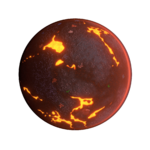 |
 |
| Oceanic jungle | Similar to Mediterranean and Prairie planets, they're lush planets, and they commonly contain sources of spiniform stalagmite crystals, crude oil, and organic crystals. |  |
 |
| Pandora swamp |  |
 | |
| Prairie | Similar to mediterranean planets, they're habitable lush oceanic planets, has less oceans, and more grasslands. They're also a good source of crude oil. Organic crystal veins can also be found there. |  |
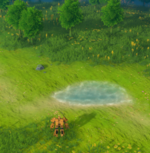 |
| Red stone | Similar to Mediterranean planets, but the soil is more reddish, and the surface is covered with mushrooms. | 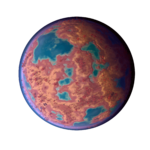 |
 |
| Rocky Salt Lake |  |
 | |
| Sakura Ocean | Similar to Oceanic jungle. Rich with crude oil and coal, this lush and colorful planet features organic crystal and most common ores. |  |
 |
| Savanna | 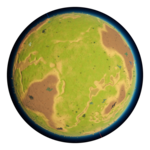 |
 | |
| Scarlet Ice Lake |  |
 | |
| Volcanic Ash | Similar to a lava planet, it's devoid of anything but volcanic activity, however, these planets are also a great source of sulfuric acid, and oceans of such are found around such planets. | 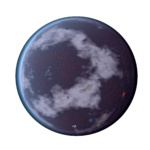 |
 |
| Waterworld | Waterworlds are almost entirely covered with oceans and constructing any large infrastructure on their surfaces will be resource and time intensive. They are also a source of spiniform stalagmite crystals which may offset those constraints for some players. It is highly recommended to bring an abundance foundations and of soil piles when setting out to set up an Ocean World mining outpost. |  |
 |
| Gas Giant | Gas Giants are commonly found around the universe, and are a good source of Deuterium and Hydrogen by using Orbital Collectors. |  |
 |
| Ice Giant | Ice Giants are less commonly found around the universe, but are a good source of Fire Ice and Hydrogen by using Orbital Collectors. |  |
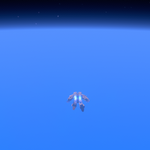 |
According to this reddit post, all terrestrial planets appear to follow the same grid layout:
5x20 (Including the pole, forms a 9 diameter disk around the pole)
5x40
5x80
5x100
10x160
10x200
15x300
15x400
25x500
25x600
50x800
80x1000
Equator (1x1000)
These grids meet at latitudes of approximately 88, 86, 84, 82, 79, 75, 70, 65, 55, 46, 28, and 0 degrees North and South.
When building on a seam between the different bands, buildings will snap to the band closest to the equator.
Stellar objects
| Class | Image | Description |
|---|---|---|
| Class M star |  |
The lowest mass stars are commonly referred to as Red Dwarf stars. They are the most abundant class of star, however, their luminosity is very low, making it very impractical to construct Dyson Spheres or even Dyson Swarms around them. |
| Class K star |  |
A low mass star, they typically have a luminosity of < 1 L☉, making them poor sites for construction of Dyson Spheres. Dyson Swarms may however still be of some use with their much lower resource requirements. |
| Class G star | 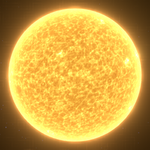 |
This is the class of star of which the Sun is a standard member. They typically have a luminosity of ~1 L☉. While they can make good use of Dyson Spheres and Dyson Swarms, higher luminosity stars may be a better location for Dyson Sphere construction.
The starting system is always around a class G star. |
| Class F star |  |
These stars have a higher luminosity while being of similar size to Class G stars. This makes them better sites for construction of Dyson Spheres, should no Class A or above stars be nearby. |
| Class A star |  |
This class have fairly high luminosity, while not being particularly large. This makes them good sites for construction of Dyson Spheres if materials are more limited, or there are no nearby Class B or O stars. |
| Class B star |  |
This class have a high luminosity, while not being as large as Class O. This makes them excellent sites for construction of Dyson Spheres if materials are more limited. |
| Class O star |  |
The brightest star type, ideal for constructing Dyson Spheres around them. However, they also tend to be the largest, and so require more materials to do so. |
| Giant star |  |
Can be of any spectral class that main sequence stars belong to. Giants are >10R⊙ (with exceptions) and have higher luminosity than their main sequence counterparts. Depending on spectral class, they are referred to as Red, Yellow, White and Blue giants. M-class Red giants and B-class Blue giants are the most common giant stars in the universe, while Yellow and White giants are extremely rare. |
| White Dwarf |  |
A stellar remnant following a nova, composed of electron-degenerate matter. Low luminosity makes them poor sites for construction of Dyson Spheres. Dyson Swarms may however still be of some use with their much lower resource requirements.
Non-giant planets orbiting White Dwarves are guaranteed to have veins of Fractal Silicon, Kimberlite Ore and Optical Grating Crystal. |
| Neutron Star |  |
A stellar remnant following a supernova, composed of neutrons with a shell of electron-degenerate matter. Low luminosity makes them poor sites for construction of Dyson Spheres. Dyson Swarms may however still be of some use with their much lower resource requirements.
It is one of the rarest stars, only one will be generated in a cluster. Unipolar Magnets can only be found on host planets orbiting a Neutron Star or Black Hole. |
| Black Hole |  |
A massive stellar remnant following a supernova, it has collapsed behind an event horizon. Usually surrounded by an accretion disc. Their extremely low luminosity makes construction of Dyson Spheres or Dyson Swarms a vanity project, as they will produce little power.
It is one of the rarest stars, only one will be generated in a cluster. Unipolar Magnets can only be found on host planets orbiting a Neutron Star or Black Hole. |
Sources of rare veins
| Commonly found on habitable planets (Oceanic Jungle, Pandora Swamp, Prairie, Red Stone, Sakura Ocean, Savanna planets). Also occurs on roughly every second Crystal Desert planet. | |
| Commonly found on Ice Field Gelisol, Frozen Tundra and Scarlet Ice Lake planets and Ice Giants. Also occurs on Ashen Gelisol and Barren Desert planets. Only rare resource aside from Crude Oil that can spawn in the starting system. | |
| Commonly found on habitable and oceanic planets (Mediterranean, Oceanic Jungle, Pandora Swamp, Prairie, Red Stone, Sakura Ocean, Savanna and Waterworld planets). Guaranteed to be found on the starting planet. | |
| Commonly and abundantly found on Waterworld planets. Also occurs in smaller quantities on habitable planets (Oceanic Jungle, Pandora Swamp, Prairie, Red Stone, Sakura Ocean and Savanna). | |
| Only found on Volcanic Ash planets. | |
| Commonly found on Frozen Tundra planets. Also occurs on Arid Desert, Barren Desert, Gobi, Hurricane Stone Forest, Lava and Scarlet Ice Lake planets and rarely on
Ashen Gelisol and Ice Field Gelisol planets. Guaranteed to spawn on planets orbiting White Dwarves. | |
| Commonly found on Pandora Swamp, Ice Field Gelisol, Ashen Gelisol, Hurricane Stone Forest, Gobi, and Lava planets. Also rarely found on Frozen Tundra planets and very rarely on Scarlet Ice Lake and Barren Desert planets. Guaranteed to spawn on planets orbiting White Dwarves. | |
| Only found on planets (Frozen Tundra and Ice Field Gelisol planets) orbiting Neutron Stars or Black Holes. | |
| Commonly found on Crystal Desert planets. Also occurs on Frozen Tundra, Hurricane Stone Forest, Scarlet Ice Lake and Ice Field Gelisol planets and rarely on Barren Desert, Lava, Rocky Salt Lake, Gobi and Ashen Gelisol planets. Guaranteed to spawn on planets orbiting White Dwarves. | |
| Only found on Gas Giants. |
State of stellar objects
Planets can have multiple physical attributes and states, which are listed below.
| Name | Description | Image |
|---|---|---|
| Tidal locking (TL) | Planets that has the same rotational period as orbital period, and consequently has one side permanently facing its host star or planet. Very useful to capture the host star's energy via solar panels and/or ray receivers | |
| Sattelite (SAT) | Astronomical objects that orbit another object that isn't a star, or in simpler terms, a moon. The starter planet is one example of such object. However, building EM-rail ejectors would be problematic, as the orbiting parent can block the sun, rendering them useless until the orbiting object passes, this decreases the time the EM-rail ejectors can fire sails, and decreases their effeciency. | |
| Reverse Rotation (RR) | The astronomical object in question rotates in the reverse direction, or clockwise when viewed from one of the poles. | |
| Horizontal Rotation (HR) | The planet has an axial inclination close to 90° causing it to rotate around a horizontal axis when viewed from the stellar poles. Still experiences seasons. | |
| Orbital Resonance (OR) | The planet has longer days. Orbital resonance 1:2 would mean a cycle of two days per year and 1:4 four days per year. Orbital resonance of 1:1 would be tidal locked. |
See also












